Introduction
Software Testing Life Cycle (STLC) is a vital section of software development process that ensures the quality and functionality of the software before it reaches customers. Every phase in STLC is intended to identify possible errors and enhance overall performance of the software. In this comprehensive guide, we will look into each phase involved in STLC outlining their significance, procedures and best practices.

Table Of Content
- Introduction to STLC
- Requirements Analysis
- Test Planning
- Test Case Development
- Test Environment Setup
- Test Execution
- Test Cycle Closure
- FAQ’s
Introduction to STLC

The STLC comprises several distinct stages:
1. Requirements Analysis
2. Test Planning
3. Test Case Development
4. Test Environment Setup
5. Test Execution
6. Test Cycle Closure
Each of these stages plays a vital role in ensuring the software meets the desired quality standards.
Requirements Analysis

The first stage in the STLC is Requirements Analysis. During this phase, testers go through software requirements to have a clear understanding of what needs to be tested. Its main objectives include identifying testable requirements, determining the scope of testing, and pointing out ambiguities or inconsistencies in the requirements.
Requirement management tools such as JIRA and Confluence among others are used to document and track down all requirement changes. These tools help ensure that there are no missing requirements and that any changes made are properly managed.
Gathering Requirements
Stakeholders are the people who provide all necessary information to the testers. These requirements could be performance-based, non-functional, or security-related.
Analyzing Requirements
From this requirements analysis, testers will identify elements that can be tested. Requirements should be both clear and complete which means they must also be able to be tested.
Documenting Requirements
A Requirement Traceability Matrix (RTM) documents all gathered and analyzed requirements. The RTM helps track the requirements throughout the testing process.
Requirement Traceability Matrix
Through RTM every specified requirement can be linked with its corresponding test cases thus ensuring all requirements are met in testing and making it possible to trace test coverage easily.
Test Planning

Test Plan Creation
Test planning is the activity of creating a test plan that describes the testing strategy, objectives, resources, schedule, and deliverables in detail. This test plan will serve as a roadmap for all testing activities.
Identification of Test Metrics
To measure the effectiveness and efficiency of the testing process it is important to define test metrics. Examples of these metrics are defect density, test coverage, or test execution rates.
Test Case Development
How to Write Effective Test Cases
Detailed test cases are written in the development phase based on the requirements. Every test case has to provide a good explanation of its input, the steps of running it, and the expected results.
Process of Reviewing Test Cases
Reviewing test cases is necessary to ascertain whether they are all-inclusive and accurate. There exist different ways, such as peer reviews and walk-throughs, that can be used for reviewing test cases.
Test Environment Setup

Configuring the Test Environment
Setting up the test environment involves configuring the hardware and software required for testing. This includes setting up servers, databases, and networks to replicate the production environment as closely as possible.
Test Data Preparation
Test data needs to be prepared to execute the test cases. This data should be realistic and should cover all possible scenarios to ensure thorough testing.
Understanding Software Quality Assurance
During the test execution phase, the test cases are executed, and the actual results are compared with the expected results. Any deviations are logged as defects.
Defects identified during test execution are logged in a defect tracking tool. Detailed information about the defect, including steps to reproduce, severity, and priority, should be documented.
Test Cycle Closure
The test closure phase involves summarizing the testing activities and outcomes in a test closure report. This report includes metrics, defect statistics, and an overall assessment of the quality of the software.
FAQ’s
1. What is the key difference between STLC Vs SDLC
While both STLC and SDLC are essential for software development, they serve different purposes. SDLC focuses on the overall development of the software, while STLC is specifically concerned with testing.
2. What is the Software Testing Life Cycle (STLC)?
The Software Testing Life Cycle (STLC) is a series of phases that test teams follow to ensure software quality. It includes phases like requirement analysis, test planning, test case development, test environment setup, test execution, and test cycle closure.
3. Why is STLC important?
STLC is important because it provides a structured approach to testing, ensuring that software meets quality standards. It helps identify defects early, reducing the cost of fixing them later and improving overall software reliability.
4. What tools are used in STLC?
Common tools used in STLC include test management tools like TestRail and Quality Center, automation tools like Selenium and QTP, and defect tracking tools like JIRA and Bugzilla.
5. How does STLC differ from SDLC?
STLC focuses solely on the testing aspects of software development, while SDLC encompasses the entire software development process, including planning, design, development, testing, deployment, and maintenance.
6. What are some best practices in STLC?
Best practices in STLC include early involvement of testers, thorough documentation, continuous communication, regular reviews, and the use of automation tools to increase efficiency and effectiveness.
Conclusion
Software Testing Life Cycle (STLC) is an essential part of the software development. By following well-defined and orderly process, STLC ensures that software products are high quality, user requirement based and dependable. Understanding and implementing STLC effectively can lead to a big improvement in the overall achievements of software projects.















